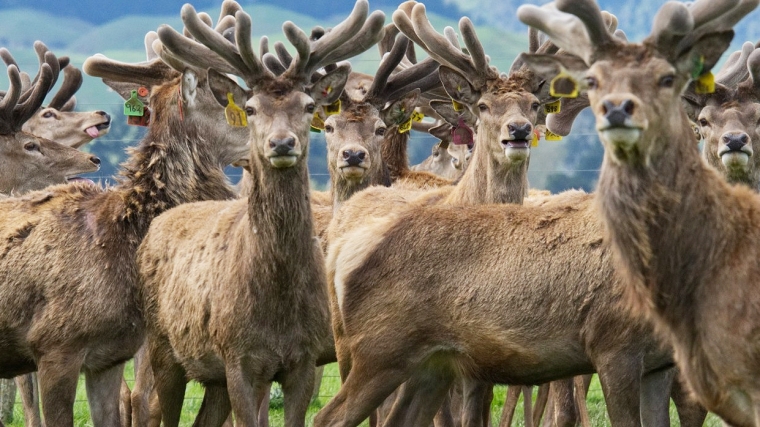
Rhys Griffiths is no stranger to challenges. Since stepping into his new role at Deer Industry New Zealand (DINZ), he has been navigating a landscape that is equal parts exciting and complex. With market access hurdles, shifting global demand and tariff uncertainties, the road ahead is not without its bumps. But as Rhys puts it, he’s supported by “a fantastic team, an awesome board,” and a shared focus on delivering for farmers.
While venison has remained steady, the velvet side of the industry has had a more difficult season. Velvet prices have been “pretty disappointing, to be fair,” and not reflective of their true market value. The challenges stemmed from export disruptions to China and the fallout from misinformation in the wholesale market.
At the heart of the problem was a misalignment between the New Zealand-China trade protocol and domestic Chinese policies. Chinese Pharmacopeia requires velvet to be dried to less than 13% moisture, while New Zealand had been exporting frozen velvet. This led to uncertainty and eventually, a halt in imports. To their credit the Ministry for Primary Industries (MPI) worked closely with Chinese officials to resolve the issue, and by 31 October 2024, a new protocol was in place and exports could resume.
While the resumption of trade was a positive step, the damage had already been done. Some importers had taken commercial risks, purchasing large volumes of velvet before the protocol was signed. Once trade resumed, this oversupply led to downward pressure on prices. Rhys believes the real frustration came from how misinformation was used to push prices down. “It was just that kind of fear created by a sense of uncertainty,” he says. “People played on that and started setting a price that, for most was really unsatisfactory.” The concern is not just about this season’s returns but about ensuring long-term confidence in the supply chain.
DINZ cannot control prices, but it can influence demand. Rhys is focused on the bigger picture, particularly in markets like South Korea, where functional food claims are adding new credibility to New Zealand velvet. Two major pharmaceutical companies have already completed or are undertaking human clinical trials, with one having secured an official claim around prostate health and anti-fatigue. These claims open the door to wider consumption and regulatory trust. The goal is clear: lift demand, create new pathways for high-value products and ensure New Zealand velvet is treated as a premium, science-backed ingredient in global health food markets.
Venison is also showing promising green shoots. South Korea is again on the radar, with a recent tasting event hosted by New Zealand’s Ambassador and featuring Michelin-star chefs. Contracted chef Graham Brown was sent to showcase New Zealand venison, and the response was overwhelmingly positive. Rhys notes that South Korea ticks many boxes: “They love red meat, they’re health-conscious, and they already know and respect deer products. So why not venison?” It’s still early days, but the potential is there.
In the United States, DINZ has launched the North American Retail Accelerator Programme. Backed by MPI and industry co-investment, the initiative was launched in July 2024 and aims to grow retail venison sales to $10 million annually by the end of its third year. The early signs are promising. Rhys says the industry is already approaching that milestone in the first year. “The companies are really excited,” he says. “They’re working together on strategies and seeing real opportunity in the retail space.”
The programme was born out of a harsh lesson during the pandemic. When restaurants closed, the industry’s heavy reliance on food service left it exposed. The retail pivot which began during COVID, has since become a formal and strategic part of the market. But that doesn’t mean DINZ is backing away from food service. Rhys is quick to clarify that strong sales continue in the restaurant trade. The aim is to diversify channels, increase resilience and ultimately deliver better returns to farmers.
Tariffs of course are the wildcard. The 10% tariff on venison into the United States is not ideal, but Rhys doesn’t see it causing too much damage. Venison is sold in the premium segment, often alongside products like bison and he believes most consumers in that space won’t be put off by a marginal price difference. If anything, venison may benefit if buyers begin to look for alternatives to bison that offer similar quality at a slightly lower cost.
Still, Rhys has his eyes on broader risks. The real concern lies in what happens once the current 90-day pause on new US tariffs expires. Larger tariffs in other markets such as China, South Korea and Japan could impact not just deer products but the entire New Zealand primary sector. It is very much a “watch this space” scenario, but DINZ is monitoring developments closely.
In the meantime, DINZ continues to explore new opportunities. Rhys is optimistic about emerging markets, including the potential unlocked through free trade agreements like the one with India. In the US, the velvet market continues to cater mainly to affluent Asian expats who already understand its traditional uses. Outlets from partners like Korean Ginseng Corporation and Beijing Tong Ren Tang are helping serve that audience, but over time functional food claims could start to win over more Western consumers as well.
The mood, while cautious in places is largely hopeful. A recent store opening by Beijing Tong Ren Tang in Auckland is a tangible sign of progress. The partnership, born out of a 2023 memorandum of understanding signed during Premier Li’s visit to New Zealand, is a strategic one and Rhys believes it will open more doors for cross-border e-commerce and broader global distribution.
For Rhys the work is far from finished, but the signs are encouraging. “It’s an awesome industry,” he says. “We’ve got great people, and my feeling is how can we do better to reward them better?” That question is central to everything DINZ is doing, whether it’s building new markets, protecting access or making sure deer farmers have the tools and confidence to thrive.
As the Deer Farmers Association prepares to celebrate its 50th anniversary in 2025, Rhys is already thinking about the next 50 years. With better market clarity, stronger demand strategies and a continued focus on values, the future of the deer industry may be challenging, but it is also full of promise.
Have a listen to the podcast to hear the full story.
Angus Kebbell is the Producer at Tailwind Media. You can contact him here.

We welcome your comments below. If you are not already registered, please register to comment.
Remember we welcome robust, respectful and insightful debate. We don't welcome abusive or defamatory comments and will de-register those repeatedly making such comments. Our current comment policy is here.